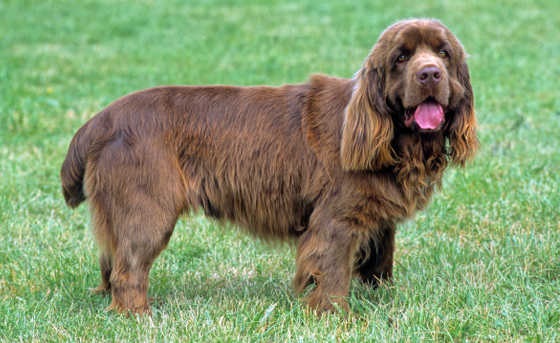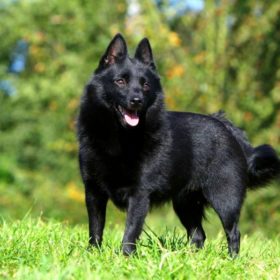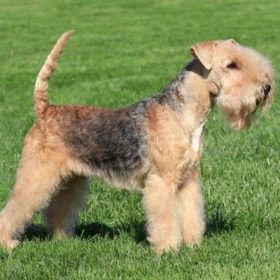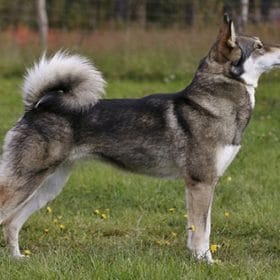Sussex Spaniel

It is a pretty calm and balanced dog with a cheerful disposition, slightly phlegmatic. Sussex Spaniel is very good-natured, loves all family members, loyal to the owner. The pet adores children, actively playing with them. With other animals, except birds, get along perfectly. The dog of this breed is sociable, easily finds a common language with everyone.
Table of Contents
Breed Information
| Another Name | – |
| Origin | England |
| Height | Males 38-41 cm Females 33-38 cm |
| Weight | 16-20 kg |
| Fur | Long |
| Color | Golden brown |
| Lifespan | 12-15 years |
| FCI Classification | Retrievers – Flushing Dogs – Water Dogs |
| Group | Hunting dogs, dogs for kids, dogs for apartments |
| Price | $500-800 |
Breed Photos
Origin History
The dog first appeared in 1792 in Goodwood, West Sussex. The breed is named after the region, and its ancestors were the Field Spaniel, the Clumber Spaniel, and the English Springer Spaniel. The creator of the Sussex Spaniel is believed to be John Mad Jack Fuller. The British Kennel Club registered the breed in 1872. Thirteen years later, the first standard for the breed appeared.
The dog was never trendy, and during World War II, the population may have disappeared altogether. Through the efforts of British breeder Jay Freer, the Sussex Spaniel was saved. The modern standard of the breed was adopted in the 21st century in 2009.
Appearance
The Sussex Spaniel has a strong, stocky, rectangular body. The chest is deep, and the back is straight and muscular. The neck is long and strong, slightly curved. The head is broad, with a pronounced occipital tubercle. The dog’s muzzle is square and long. The nose bridge is brown. The eyes are the same color, medium size. The ears are floppy, long, covered with thick hair.
Its limbs are strong and muscular, with the hind legs slightly longer than the front. The spaniel’s trimmed tail does not hold above the back. The coat is shiny, thick, and long. The color is golden brown.
Character
It is a pretty calm and balanced dog with a cheerful disposition, slightly phlegmatic. Sussex Spaniel is very good-natured, loves all family members, loyal to the owner. The pet adores children, actively playing with them. With other animals, except birds, get along perfectly. The dog of this breed is sociable, easily finds a common language with everyone. To strangers treats warily, but without aggression. So guarding a dog alas will not work.
Care
The Sussex Spaniel is suitable for keeping both in a country house and in an apartment. In the second case, you need to take the dog for a long and regular walk. He needs to get out all his energy and get some fresh air.
Long hair should be combed out 3-4 times a week. When molting, it should be done every day. It is also important to trim the hair on the ears and between the finger pads. Repeat this procedure at least 3-5 times a year. Do not forget to inspect and clean the dog’s ears and eyes from dirt. You should also trim your pet’s nails.
Training
The Sussex Spaniel is an obedient and intelligent dog that is easy to train. The only hindrance may be his somewhat phlegmatic and unhurried nature. Be patient and don’t yell at him for anything. It is a gentle and gentle creature, which does not tolerate rudeness on its side. It’s better to give him the command once more or motivate him with treats. This way, you will achieve results with greater probability. Training should include lots of physical activity and outdoor walks. Make training sessions fun games to keep your dog interested and engaged.
Common Diseases
Overall, the Sussex Spaniel is a healthy and robust dog. The pet’s eyes and mouth are considered weaknesses. Diseases characteristic of the breed:
- hip dysplasia;
- stenosis of the pulmonary artery valve;
- osteochondrosis;
- otitis externa.
To prevent infections, clean your dog’s eyes and ears regularly. Also, pay attention to the health of your pet’s teeth, which are prone to tartar. Brush them with a special brush or give your dog chew bones like dental. Take your four-legged dog to the vet regularly so that all diseases can be diagnosed and treated in time.
Nutrition
Feed an adult Sussex Spaniel twice a day, a puppy – 5-6 times a day. The basis of the pet’s diet should be meat and by-products. Raw or boiled beef is best. You can also give your dog porridges, vegetables, dairy products, and fish.
A source of vitamins in the four-legged dog’s body will be fruits and greens. It’s best to feed your spaniel after a walk. Food is eaten before exercise can provoke gut worms or constipation. Ready-made dry food is also good for your pet’s diet.
 Schipperke
Schipperke Lakeland Terrier
Lakeland Terrier Bichon Frise
Bichon Frise East Siberian Laika
East Siberian Laika Redbone Coonhound
Redbone Coonhound Tibetan Terrier
Tibetan Terrier


